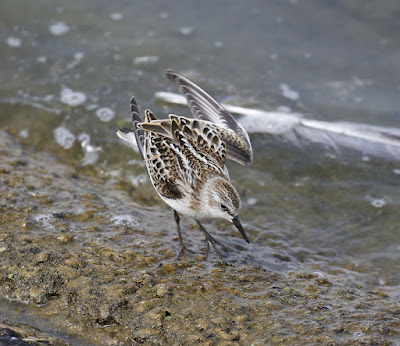The weather forecast for tomorrow is dire. Steady rain. So it was back to Farmoor today while the opportunity was there, for some more communing with the juvenile Little Stints, still running energetically along the water's edge below the central causeway.
Just as yesterday Farmoor was warm and sunny, and today many excited school kids were getting some sailing instruction on the larger reservoir, Farmoor Two, but it was the smaller undisturbed Farmoor One reservoir for me where I could sit on the low retaining wall and watch the stints to my heart's content at the water's edge.
Like yesterday there were only three other birders present which to me seems strange as here is a golden opportunity to study, at exceptionally close quarters, a species that does not often offer such an opportunity.
It's not all about chasing after rare birds, as for me there is also much satisfaction and fulfilment in watching and learning about a bird that is not a rarity but catches my imagination and enthusiasm, and here was such an opportunity.
It's not all about chasing after rare birds, as for me there is also much satisfaction and fulfilment in watching and learning about a bird that is not a rarity but catches my imagination and enthusiasm, and here was such an opportunity.
There is always something to learn or re-learn from any such observations, so I sat quietly on the wall and watched. Sure I took some more pictures but I had done most of this part yesterday and now wanted to just take time to relax, absorb and enjoy what I saw of these two tiny birds.
In the back of my mind was once again the acknowledgment of the almost miraculous circumstances that surround these bird's existence and their presence here. Tiny, as they are when full grown individuals, how small were they when they emerged from an egg on the vast empty tundras of Arctic Europe or Siberia? In some years when the lemmings are scarce they would do well to survive, as predators such as skuas and Snowy Owls substitute them and other wader chicks for their usual diet of lemmings, and then, of course, there is also the weather. Freak storms, rain and even snow could spell disaster as they get chilled and are unable to search for food. Having survived these and other hazards on their breeding grounds they finally set off on an independent journey into the unknown.
Never having migrated before, they head up into the sky, driven by instinct and genetic imprinting to make a perilous marathon journey to southern Africa where they will spend the winter. They do stop on the way and here were two that had made it as far as Oxfordshire but still had thousands of miles to go. No wonder they take any opportunity available to relax in the sun, sleep and preen their all important flight feathers, in-between bouts of frantic feeding.
 |
| Little Stint feather maintenance |
When near to one or more of the Dunlins that were sharing the feeding opportunities with them it could clearly be seen how small the stints were. I noted, as I did yesterday, the slight difference in plumage tones of the two stints. One having richer and warmer colour tones on its upperparts making it appear rufous whilst the other was paler and greyer. This two colour variation is noted in some reference books and the grey one is said to be unusual but I was unaware of it until I saw these two birds and then went to the reference books for confirmation. So you see, there is nothing to beat 'in the field' observation!
 |
| Note the smaller size of the Little Stint (back) compared to the Dunlin (front) Only 2/3rd the size of the Dunlin |
 |
| The two Little Stint in close proximity showing the differing colour tones on their upperparts |
 |
| Note the somewhat inconspicuous split supercilium of the Little Stint |
 |
| Two Little Stints and four Dunlin - all juveniles |
 |
| Little Stint squatting on the concrete |
 |
| The Little Stints and a couple of Dunlin taking a break from feeding |
Whilst feeding, the stints would occasionally partially open one wing. Not a full stretch but just a partial one whilst they carried on moving and feeding. When a full wing stretch was performed they would stop and relax into the stretch, slowly extending the wing and the leg before again slowly bringing them back into position.
 |
| Little Stint - partial wing stretch |
 |
| Little Stint - full wing and leg stretch |
I also rejoiced in the fact that this delightful species is listed as of Least Concern by Birdlife International, meaning its population remains at a good level in this troubled world, so hopefully there will be more Little Stint Farmoor experiences to come. I do hope so.























No comments:
Post a Comment